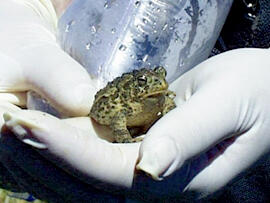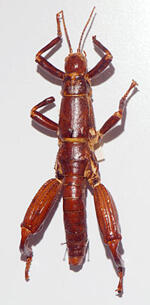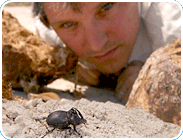Dear Rex,
Unfortunately, there are many, many highly endangered species in the world. They have become endangered for many different reasons. And it's impossible to tell which one is absolutely in the worst shape.

What is the most endangered animal on Earth right now?
— Rex R. Grade 4
Invertebrate ecologist Sacha Spector answers this question:
Dear Rex,
Unfortunately, there are many, many highly endangered species in the world. They have become endangered for many different reasons. And it's impossible to tell which one is absolutely in the worst shape.
For example, the Wyoming Toad (Bufo baxteri) is one of the most endangered amphibians in the world. It is hanging on in just one lake in, you guessed it, Wyoming. This species of toad is threatened by a fungal infection and habitat loss. It only manages to survive in the wild because the US Fish and Wildlife Service breeds adult toads in captivity, and then releases juveniles into the wild each year.

The tiny Wyoming Toad only grows to about 5 cm (2 in) long.
Another example is the Lord Howe Island Stick-insect (Dryococelus australis). By the 1930s, this species was thought to have gone extinct when rats were introduced to its only habitat, Lord Howe Island off Australia. But in 2001, an expedition to a nearby island found 24 individual insects living on a single cluster of bushes! Today, conservation efforts in Australia have boosted the population to almost 50 individuals, but this species is still critically endangered.
These are just two examples of species that are teetering on the brink of extinction, but there are many more. It's important to remember that there are also many species (not just animals) that are so poorly known that we don't know for sure if they're endangered, extinct, or doing just fine.

The Lord Howe Island Stick-insect is among the world's largest insects. It can grow to about 15 cm (6 in) long!
Scientists around the world are working to find the last populations of endangered species and are documenting more endangered species than ever before. We can all pitch in by consuming fewer resources. We can also let our leaders know that we care about the environment and the species we live with here on Earth .
You Can Make a Difference!
Explore More:

Name:
Sacha Spector
Job Title:
Invertebrate Conservation Program Manager, Center for
Biodiversity
& Conservation
Known For:
Sacha is an
invertebrate
ecologist — he studies animals without backbones. Sacha develops conservation strategies to locate threatened species of insects, spiders, and other invertebrates. He also find ways to protect them.
Cool Fact:
Sacha's specialty organisms are the dung beetles. They are a really important group of insects that help keep the world's ecosystems running. The beetles remove wastes, suppress pests, and disperse seeds. Sacha has studied dung beetles on 5 continents to learn about their conservation needs. He also discovered several new species.
Wyoming toad, courtesy of USFWS; Lord Howe Island Stick-bug, Peter Halasz via Wikipedia (CC BY-SA 3.0); Sacha Spector, courtesy of Sacha Spector.